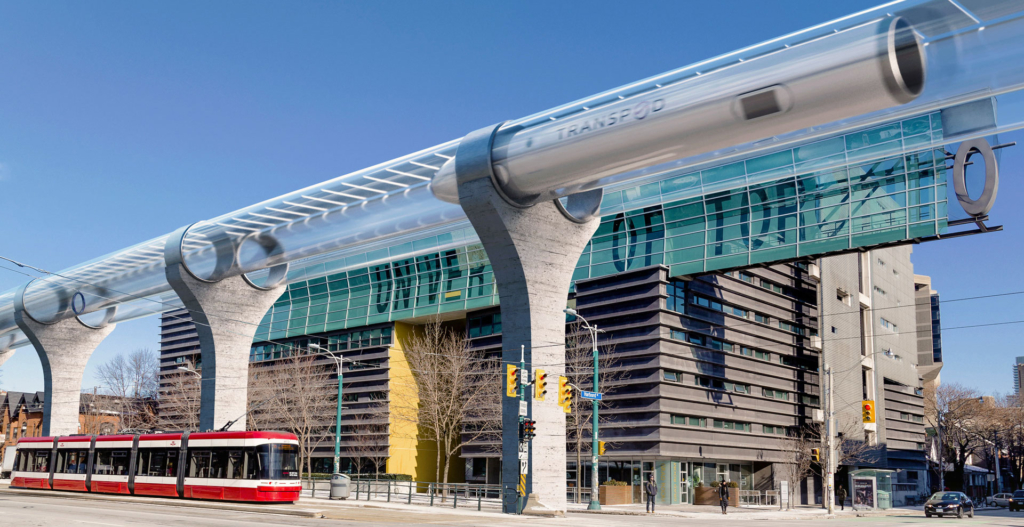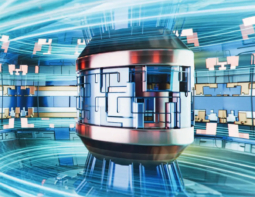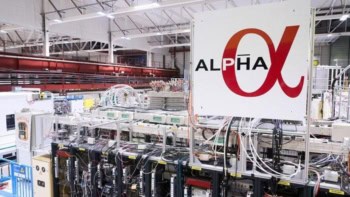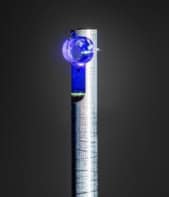Vacuum-based hyperloop technology could transport passengers between cities cheaply at more than half the speed of sound – or so its proponents claim. Jon Cartwright takes a closer look
In the late summer of 1864, anyone wanting to travel along the east side of Crystal Palace Park in London could buy a train ticket for sixpence – but this was no ordinary railway. Designed by the British engineer Thomas Webster Rammell, the Crystal Palace pneumatic railway consisted of a carriage that fitted snugly inside a tunnel, such that when a huge fan was turned on, the carriage was sucked from one end of the tunnel to the other. Average speeds of around 40 km/h meant that passengers could make the 550 metre trip in a little under a minute – twice as fast as the carriage’s horse-drawn competitors.
Rammell’s pneumatic railway was experimental, and it only ran for two months. A century and a half later, however, the idea of getting from A to B inside depressurized passages is back, thanks to another entrepreneurial visionary: Elon Musk, the South-African born, Canadian-American multibillionaire behind Tesla electric cars and SpaceX rockets. In 2013 Musk published a white paper outlining the concept of a hyperloop: an evacuated steel tube through which passenger “pods” travel cheaply and efficiently over continental distances. Thanks to the minimal air resistance, Musk claimed, the pods could be accelerated to speeds of up to 760 km/h.
The hyperloop sounds almost too good to be true, and many critics have said as much, branding Musk’s idea impractical, unsafe and – for various political and economic reasons – unrealizable. But in the four years since Musk’s white paper, at least three major start-ups have been created, and dozens of academics and industry professionals have climbed on board – figuratively if not yet literally. Their hope is to revolutionize public transport and, in so doing, restructure society for the better.
Simple on paper
Few deny the basic principles behind the hyperloop. At atmospheric pressure, air resistance mounts swiftly with speed, which is why supersonic jets tend to fly at high altitude. To avoid consuming huge amounts of energy, therefore, a near-sonic or supersonic vehicle at ground level needs an evacuated environment in which to travel. A tube is the obvious solution, although one containing a near vacuum would have to be resistant to the tiniest crack or leaky seal. For that reason, Musk proposed a tube containing merely low-pressure air, at about one millibar.
This residual air brings a problem, however, in that a snugly-fitting vehicle will, at high speeds, have to push an entire air column ahead of it – “not good”, in Musk’s words. The entrepreneur therefore proposed mounting a compressor fan in the nose of the hyperloop pod to transfer air backwards. In fact, he said, the air could even be channelled beneath the pod, creating a cushion for the pod to ride on, like an air-hockey puck. Meanwhile, contactless linear induction motors, placed at intervals along the tube, would supply an alternating magnetic field to accelerate the pod.
Musk claimed that he and his SpaceX company were too busy to work on a hyperloop themselves (other projects in the works include a plan to colonize Mars), but he encouraged others to pick up the baton. Within months a German entrepreneur, Dirk Ahlborn, obliged by setting up Hyperloop Transportation Technologies (HTT) in the US; hot on his heels came Shervin Pishevar, an Iranian-American entrepreneur who was reportedly responsible for persuading Musk to release the hyperloop white paper in the first place. Pishevar called his US company Hyperloop Technologies, though it was subsequently rebranded as Hyperloop One.
Both HTT and Hyperloop One claim to have amassed investments of $100m or more. Both, too, have revised various aspects of Musk’s original design, favouring different implementations of magnetic levitation, or “maglev”, over air cushioning. But concrete advances have been slower. HTT has gone quiet on previous claims that it would have a prototype hyperloop running as soon as 2018. Hyperloop One has delivered more visible progress, carrying out a linear-motor propulsion test just north of Las Vegas, US, in May 2016; on the other hand, its “first flight” of a fully functioning hyperloop, scheduled for early 2017, had not yet taken place at press time.
A third start-up, TransPod, entered the scene in 2015. Although this Canada-based firm has had less public exposure than HTT and Hyperloop One, co-founder Ryan Janzen believes it stands a better chance of success because none of its major components are going to come off the shelf; instead they are all being designed specifically to suit the needs of their hyperloop technology, drawing on expertise from across the rail, aerospace and space, and architecture sectors. “I like to say that we’re building a spacecraft that’s shaped like a plane, and operates like a train,” Janzen says.
TransPod hopes to deliver a “commercially viable product” by 2020, and has developed algorithms that can design optimal routes between cities, taking into account geography and existing infrastructure. One of the routes it is considering is the 550 km stretch between Toronto and Montreal, which currently takes one and a half hours by plane or up to six hours by car. A hyperloop, TransPod claims, could cut this journey time to 45 minutes.

Like many hyperloop proponents, Janzen believes the infrastructure cost would be roughly similar to that posed by high-speed rail, which is seen as the main competitor. But many independent engineers are sceptical about this, given the cost overruns that often occur with major infrastructure projects, even when the technologies involved are well-established. (In the UK, for example, cost estimates for a proposed north-to-south high-speed railway have spiralled from £30bn to more than £80bn.) And as control-systems engineer Roger Goodall at Loughborough University in the UK explains, cost is not the only potential barrier. Among his concerns are the integrity of evacuated tubes over large distances, especially when tubes have to fork into different routes, and the possibility that passengers would have to stomach accelerations of 0.5 g on banked curves. “I suspect that working, eating and certainly moving around during the journey would not be a possibility,” he says. “Overall, it seems an interesting thought exercise for STEM students, [but] I am astonished by the substantial developments going on in the US.”
Others, though, have been less quick to dismiss the idea. Carl Brockmeyer, head of business development at the Germany-based vacuum technology company Leybold, read about hyperloops after they were first proposed and immediately wanted to get involved. “We’re not the type of people who say, ‘You’re crazy’,” he explains. “We’re the type of people who say, ‘Cool, how can we help?’” Leybold is now working with both Hyperloop One and HTT.
Brockmeyer isn’t fazed by the scale of the vacuum system required. He points out that Leybold helped to deliver the 27 km long vacuum system at the Large Hadron Collider at CERN on the Franco–Swiss border; that system needed pressures in the region of 10–11 millibar, some 11 orders of magnitude less than a hyperloop would require. “I don’t want to say ‘simple’, but let’s say it’s very achievable,” Brockmeyer says, referring to hyperloop’s pressure requirements. “We’ve delivered vacuum systems that are technically far more challenging.”
Old news?
Indeed, perhaps the hyperloop is not as cutting-edge as it appears. In the early 1980s researchers at the Swiss Federal Institute of Technology in Lausanne (EPFL) began investigating the possibility of creating an underground network of tunnels to connect the major cities of Switzerland. Known as Swissmetro, the system would have employed maglev trains travelling through reduced air pressures at speeds of up to 450 km/h.
The initial reception for Swissmetro was positive: a preliminary study was supported by the federal government, a more substantial analysis backed by the state and private sector followed, and by the late 1990s there were grounds for industrial development. But within a few years the government’s interest had waned amid claims that the system was not economically viable. Marcel Jufer, the engineer who led the EPFL group, believes the reason was that the government had already committed to building the Gotthard Base Tunnel, which runs under the Alps between Erstfeld and Bodio and is now, at 57 km, the world’s longest railway tunnel. After Swiss voters approved this north–south tunnel in 1992, there was simply no money left for an east–west Swissmetro, which Jufer says would have cost about the same. Whatever the real reason, in 2009 the Swissmetro company went into liquidation, although the EPFL group went on to discuss similar projects in South Korea and Belgium.
Should Swissmetro be taken as a salutary lesson for eager proponents of hyperloops? Jufer does not think that the new start-ups will necessarily suffer the same fate, but he knows not to underestimate the politico-economic challenges. HTT has bragged that landowners will welcome elevated hyperloop tubes running across their property in return for in-kind benefits such as free electricity, but Jufer believes the tubes would be better off buried underground to avoid any possibility of nimbyism. Though that might sound like a more expensive option, John Miles, an engineer at the University of Cambridge in the UK, points out that hyperloop tunnels would only need to be a fraction of the diameter of railway tunnels and so costs would be dramatically less.
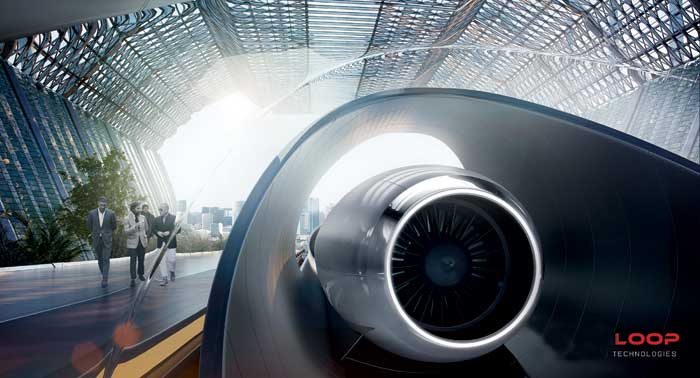
Jufer also stresses the influence of vested interests, in the form of existing rail companies. Contrary to the vision of, for example, Hyperloop One, which is exploring routes between major European cities – partly, it seems, as a marketing exercise – Jufer believes a better place to start would be somewhere like Brazil, which does not already have strong rail infrastructure. “It takes a long, long time to overcome political problems,” he says.
Obstacles to overcome
Hyperloops have no shortage of other criticisms. Sceptics have claimed that the systems will be highly susceptible to everything from power outages and acoustic noise to earthquakes and terror attacks. Although some hyperloop proponents have compared the technology to airplane travel, “a plane does not travel at 1000 km/h a few centimetres from a steel wall,” observes Paolo Chiggiato, who leads the vacuum, surfaces and coatings group at CERN. “In case of a lack of electrical power, the vessel would inevitably touch the walls or the rails on which it is normally suspended. If a shock provoked a failure in the vessel tightness, the passengers would be rapidly surrounded in vacuum.” A pressure of 1 mbar, he notes, is equivalent to atmospheric pressure 50 km above the Earth’s surface – more than 10 times higher than the cruising altitude of a typical jetliner.
There has been backroom controversy, too: last year, Hyperloop One had to settle a lawsuit filed by one of its co-founders and three other employees alleging corporate malpractice. And within the academic community the debate has not always been constructive, as rail engineer John Preston at the University of Southampton in the UK found when he attended a transportation conference in South Korea in June 2017. “There was an interesting clash between the mainstream maglev supporters and the hyperloop ‘interlopers’ on comfort and cost, but with little clarity on either except for a diversion on virtual windows,” he says.
Despite these critiques, though, some experts think it is lazy to dismiss hyperloops out of hand based on the futuristic appearance of the technology. “The natural inclination of everyone is to say it’ll never happen,” says Miles. “And before you get excited about anything you should always do some calculations. But having done those, I found that I became more inclined to believe it could happen, rather than less inclined.” Miles persuaded his former employers, the international consultancy Arup, to begin offering expertise to Hyperloop One on a non-contractual basis.
Miles is well aware of the potential technological problems. “If you put high voltage inside a vacuum tube, you end up with what is effectively a strip light,” he jokes, by way of example. But he points out that each of hyperloop’s key components – propulsion, levitation, guidance, control and reduced pressure – are all technologies that have been well established in different spheres. The goal now is to get them to work in concert.
The new Tube
The Victorians would not have been daunted by such a challenge. While passers-by marvelled at Rammell’s pneumatic railway, engineers elsewhere in London were toying with the dubious idea of an extensive underground railway, at a time when most of the city’s inhabitants were still travelling by horse and cart. “The ability to effectively introduce the London Underground at the national scale, if you could do it, would quite simply transform the economic outlook for the UK,” says Miles. “Yes, it’s quite a challenge. But having spent a fair bit of time on this now, I’ve yet to see anything that I’d regard as a showstopper.”
